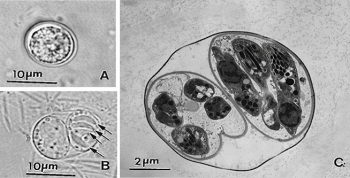Toxoplasma gondii - Laboratory diagnosis, Epidemiology, Reservoir, Transmission, Treatment
Laboratory diagnosis of Toxoplasma gondii
The lab diagnosis of Toxoplasma gondii is difficult due to symptoms mimicking a variety of other diseases.
Specimen
blood
body fluids (bone marrow aspiration, blood, CSF, aqueous or vitreous fluid)
tissue (brain biopsy/autopsy)
BAL (brnochoalveolar lavage)
lymph nodes
amniotic fluid (pregnant women)
Microscopy
Cysts or tachyzoites can be detected in body fluids or tissue specimens
stains used include Wright-Giemsa, Periodic acid-Schiff (PAS), Gomorimethenamine silver, hematoxylin and eosin, immunoperoxidase and fluorescein-conjugated antibody stains
presence of typical coma-shaped tachyzoites in tissue and body fluid indicates acute infections
observation of tissue cysts in lymph nodes and other tissue sections does not differentiate between acute or chronic infection but does suggest a high degree of host immune response

Image: Toxoplasma gondii; A- unsporulated oocyst, B- sporulated oocyst with two sporocysts, four sporozoites (black arrows), C- transmission electron micrograph of sporulated oocyst (Source: Researchgate)
Culture
The culture of Toxoplasma gondii can be done in-vitro and animal inoculation.
Animal inoculation
laboratory animals like mice or hamsters are intraperitoneally inoculated with Toxoplasma gondii
after 6 to 10 days after inoculation, peritoneal fluid is tested for the presence of tachyzoites
if no tachyzoites are found, the serum is collected 4 to 6 weeks after inoculation to screen for Toxoplasma gondii antibodies
for congenital toxoplasmosis, sample amniotic fluid is inoculated in mice for diagnosis
In-vitro culture
Toxoplasma gondii can be cultured in vitro in normal murine alveolar and peripheral cell lines in tissue culture
they are yet to be successful to be cultured in a cell-free medium
Serodiagnosis
The serodiagnosis of Toxoplasma gondii can be done by the detection of antibodies and by the detection of antigens.
Detection of antibodies
based on the detection of Toxoplasma gondii-specific antibodies in the serum
common serological methods include
enzyme-linked immunosorbent assay (ELISA)
indirect fluorescent antibody test
indirect haemagglutination test
direct agglutional test
latex agglutination test
completely purified or semi-purified tachyzoites derived from mice peritoneum are used as antigens in these assay tests
Detection of antigen
based on the detection of circulating Toxoplasma gondii antigen in the sample serum, amniotic fluid, vitreous or aqueous fluid
a positive result indicates acute infections
detection in amniotic fluid indicates congenital toxoplasmosis
very useful in rapid diagnosis of infection in AIDS or immunocompromised individuals
Molecular diagnosis
The molecular diagnosis of Toxoplasma gondii is as follows:
PCR
mostly used in samples such as CSF, BAL, amniotic fluids, blood, aqueous or vitreous fluid
Imaging methods
Ultrasound
CT scan
MRI
Epidemiology of Toxoplasma gondii
Epidemiologically, Toxoplasma gondii is the most common human parasite and the most common cause of intraocular inflammation worldwide.
The prevalence depends on the age of the population and geographical area with infection highest in the age group of more than 50 years.
Reservoir, Source of Toxoplasma gondii
The main reservoir/source of Toxoplasma gondii is the domestic cat. An infected feline sheds millions of unsporulated oocysts.
Transmission of Toxoplasma gondii
Transmission of Toxoplasma gondii infection in humans occurs via:
ingestion of tissue cysts present in raw or undercooked meat
consumption of oocysts from the soil, water, vegetables, milk
blood transfusions
organ transplantation from an infected donor
congenital transmission through the placenta from infected mother to fetus
Treatment of Toxoplasma gondii
drugs such as pyrimethamine, sulfadiazine, clindamycin atovaquone, and azithromycin are used to treat tachyzoites but are not useful for Toxoplasma gondii bradycysts
chemotherapy – used for immunocompromised and HIV patients or congenital toxoplasmosis
drugs used synergistically include pyrimethamine and clindamycin or sulfadiazine (sulfadiazine, trisulfapyrimidine)
Prevention, Control of Toxoplasma gondii
Prevention, Control of Toxoplasma gondii is done by:
avoidance of contact with cat or feline feces- especially by high-risk individuals (pregnant women or immunocompromised individuals)
consuming well-cooked meat
fruits and vegetables should be cleaned well-become consumption